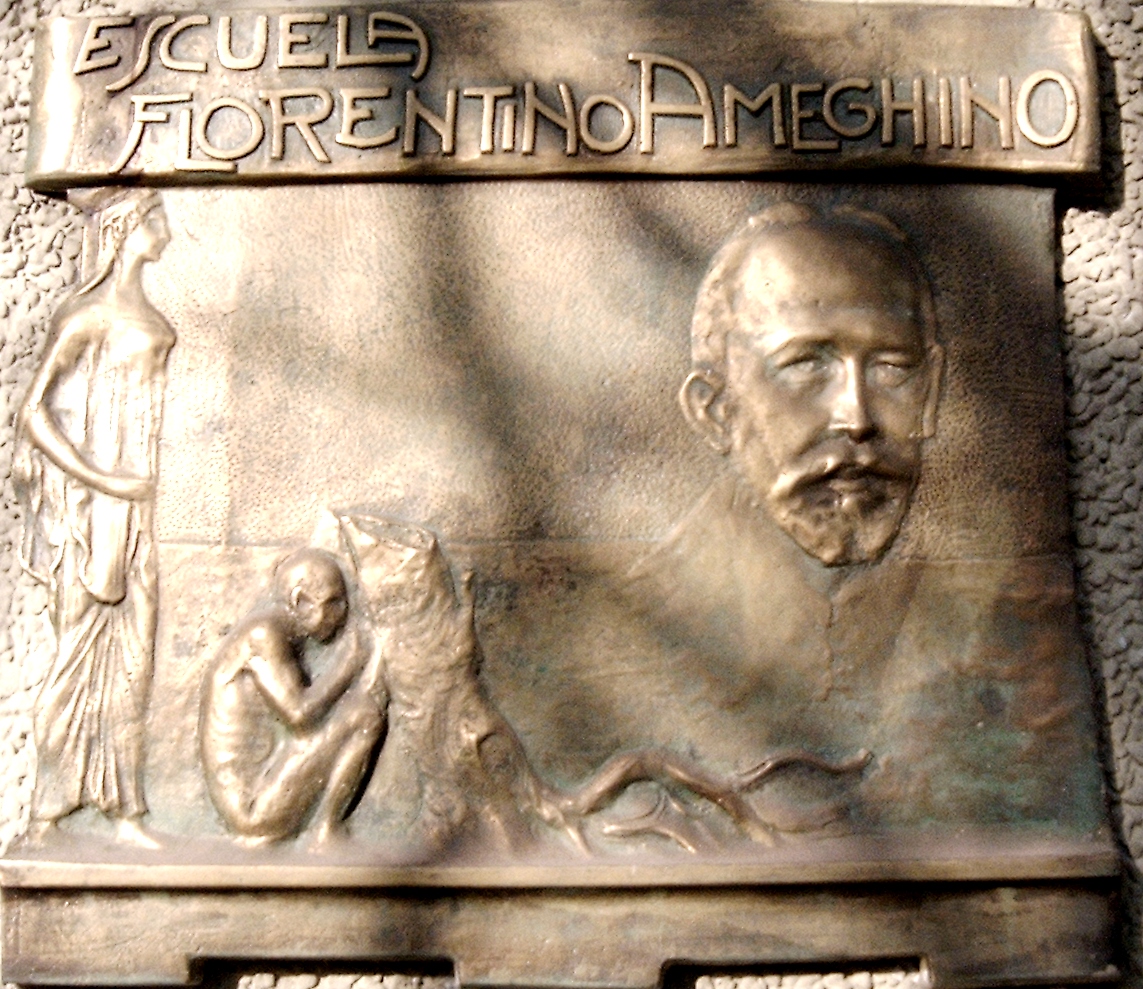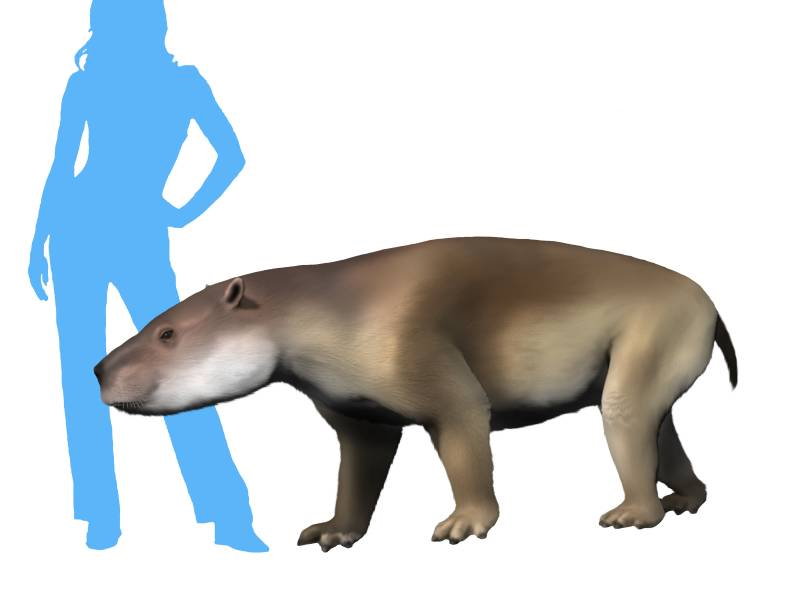|
Pyrothere
Pyrotheria is an order of extinct meridiungulate mammals. These mastodon-like ungulates include the genera ''Baguatherium'', ''Carolozittelia'', ''Colombitherium'', ''Griphodon'', ''Propyrotherium'', ''Proticia'', and ''Pyrotherium''. They had the appearance of large, digitigrade, tapir-like mammals with relatively short, slender limbs and five-toed feet with broad, flat phalanges. Their fossils are restricted to Paleocene through Oligocene deposits of Brazil, Peru and Argentina. Some experts place the clade Xenungulata (which contains several genera, including ''Carodnia'') within Pyrotheria, even when dentition, although bilophodont in both orders, is very different. For most scholars, the two orders remain separated. The dentition is complete with strong, procumbent, chisel-shaped incisors, strong sharp-pointed canines, and low-crowned cheek teeth with bilophodont molars. The affinities of the Xenungulata remain uncertain. Affinities with the Dinocerata are strongly suppo ... [...More Info...] [...Related Items...] OR: [Wikipedia] [Google] [Baidu] |
Baguatherium
''Baguatherium'' is an extinct genus of herbivorous mammal, belonging to the order Pyrotheria. It lived during the Early Oligocene, and its fossilized remains were discovered in Peru. Description Although the fossils known are very partial (a maxilla, a left femur, isolated molars, they allow a comparison with those of similar animals better known, such as ''Pyrotherium'', and it can be hypothesized that ''Baguatherium'' was a large animal with heavy forms, similar to early proboscideans or modern tapirs. Compared to ''Pyrotherium'', ''Baguatherium'' possessed a slightly wider palate and the ridges on the molariform teeth were less oblique. A notable lingual crest connecting the posterior and anterior crests of those teeth was also present. The nasal bones, as in ''Pyrotherium'', were set back and indicate the presence of a proboscis. Classification ''Baguatherium jaureguii'' was first described in 2006, based on fossilized remains found near Bagua Grande, in the Department ... [...More Info...] [...Related Items...] OR: [Wikipedia] [Google] [Baidu] |
Pyrotherium
''Pyrotherium'' ('fire beast') is an extinct genus of South American ungulate, of the order Pyrotheria, that lived in what is now Argentina and Bolivia, during the Late Oligocene.''Pyrotherium'' at .org It was named ''Pyrotherium'' because the first specimens were excavated from an ancient volcanic ash deposit. Fossils of the genus have been found in the and s of Argentina and the ... [...More Info...] [...Related Items...] OR: [Wikipedia] [Google] [Baidu] |
Griphodon
''Griphodon'' is an extinct genus of mammals, belonging to the order Pyrotheria. It lived during the Middle Eocene, in what is now Peru. Description All that is known about this animal is a fragment of a mandible complete with teeth. Its teeth were two-crested, slightly more transversal than in other genera such as ''Carolozittelia'', but there are indications of the presence of a longitudinal crest, and even, in the third premolar, of a complete crest, not found in ''Pyrotherium''. Classification ''Griphodon peruvianus'' was first described in 1924 by Anthony, who considered it to be a Perissodactyl. The fragmentary fossil was found near Chicoca, along the Huallaga River. Subsequently the genus was considered a basal member of the Pyrotheres, a mysterious clade of heavy-shaped mammals from the Early Cenozoic of South America, of uncertain affinities. Other fossils attributed to ''Griphodon'' were later found near Contamana in the Loreto Province of Peru. Paleoecology ''Grip ... [...More Info...] [...Related Items...] OR: [Wikipedia] [Google] [Baidu] |
Carolozittelia
''Carolozittelia'' is an extinct genus of mammals, belonging to the order Pyrotheria. It contains the single species ''Carolozittelia tapiroides'' which lived during the Early Eocene. Its fossilized remains were found in South America. Description This genus is only known from a few fossil teeth, and its appearance is entirely conjectural. The molars of ''Carolozittelia'' were endowed with transversal crests, but traces of tubercles from a primitive quadrituberculate dentition can still be recognized. Classification ''Carolozittelia'' was first described in 1901 by Florentino Ameghino, based on fossils found in Argentinian Patagonia, in terrains dating from the Eocene. Ameghino described two species attributed to the genus : ''Carolozittelia tapiroides'' and ''C. eluta'', the second later synonymized with the first. ''Carolozittelia'' was a Pyrothere, a clade of South American mammals of uncertain affinities, who lived during the early Cenozoic. It was one of the oldest memb ... [...More Info...] [...Related Items...] OR: [Wikipedia] [Google] [Baidu] |
Florentino Ameghino
Florentino Ameghino (born Giovanni Battista Fiorino Giuseppe Ameghino September 19, 1853 – August 6, 1911) was an Argentine naturalist, paleontologist, anthropologist and zoologist, whose fossil discoveries on the Argentine Pampas, especially on Patagonia, rank with those made in the western United States during the late 19th century. Along with his two brothers –Carlos and Juan– Florentino Ameghino was one of the most important founding figures in South American paleontology. From 1887 until his death, Ameghino was passionately devoted to the study of fossil mammals from Patagonia, with the valuable support of his brother Carlos Ameghino (1865–1936) who, between 1887 and 1902, made 14 trips to that region, where he discovered and collected numerous fossil faunas and made important stratigraphic observations which helped to support his journal Ameghiniana. Biography Ameghino was born on September 19, 1853 in Tessi, an hamlet of Moneglia, a municipality of Liguria in ... [...More Info...] [...Related Items...] OR: [Wikipedia] [Google] [Baidu] |
Brazil
Brazil ( pt, Brasil; ), officially the Federative Republic of Brazil (Portuguese: ), is the largest country in both South America and Latin America. At and with over 217 million people, Brazil is the world's fifth-largest country by area and the seventh most populous. Its capital is Brasília, and its most populous city is São Paulo. The federation is composed of the union of the 26 states and the Federal District. It is the largest country to have Portuguese as an official language and the only one in the Americas; one of the most multicultural and ethnically diverse nations, due to over a century of mass immigration from around the world; and the most populous Roman Catholic-majority country. Bounded by the Atlantic Ocean on the east, Brazil has a coastline of . It borders all other countries and territories in South America except Ecuador and Chile and covers roughly half of the continent's land area. Its Amazon basin includes a vast tropical forest, ho ... [...More Info...] [...Related Items...] OR: [Wikipedia] [Google] [Baidu] |
Peru
, image_flag = Flag of Peru.svg , image_coat = Escudo nacional del Perú.svg , other_symbol = Great Seal of the State , other_symbol_type = Seal (emblem), National seal , national_motto = "Firm and Happy for the Union" , national_anthem = "National Anthem of Peru" , march = "March of Flags" , image_map = PER orthographic.svg , map_caption = , image_map2 = , capital = Lima , coordinates = , largest_city = capital , official_languages = Peruvian Spanish, Spanish , languages_type = Co-official languages , languages = , ethnic_groups = , ethnic_groups_year = 2017 , demonym = Peruvians, Peruvian , government_type = Unitary state, Unitary Semi-presidential system, semi-presidential republic , leader_title1 = President of Peru, President ... [...More Info...] [...Related Items...] OR: [Wikipedia] [Google] [Baidu] |
Argentina
Argentina (), officially the Argentine Republic ( es, link=no, República Argentina), is a country in the southern half of South America. Argentina covers an area of , making it the second-largest country in South America after Brazil, the fourth-largest country in the Americas, and the eighth-largest country in the world. It shares the bulk of the Southern Cone with Chile to the west, and is also bordered by Bolivia and Paraguay to the north, Brazil to the northeast, Uruguay and the South Atlantic Ocean to the east, and the Drake Passage to the south. Argentina is a federal state subdivided into twenty-three provinces, and one autonomous city, which is the federal capital and largest city of the nation, Buenos Aires. The provinces and the capital have their own constitutions, but exist under a federal system. Argentina claims sovereignty over the Falkland Islands, South Georgia and the South Sandwich Islands, and a part of Antarctica. The earliest recorded ... [...More Info...] [...Related Items...] OR: [Wikipedia] [Google] [Baidu] |
Xenungulata
Xenungulata ("strange ungulates") is an order of extinct and primitive South American hoofed mammals that lived from the Late Paleocene to Early Eocene ( Itaboraian to Casamayoran in the SALMA classification). Fossils of the order are known from deposits in Brazil, Argentina, Peru, and Colombia. The best known member of this enigmatic order is the genus ''Carodnia'', a tapir-like and -sized animal with a gait similar to living African elephants. Description Xenungulates are characterized by bilophodont M1–2 and M1–2, similar to pyrotheres, and complex lophate third molars, similar to uintatheres. Though other relationships, to arctocyonids for example, have been suggested, no proofs thereof have been found. The foot bones of xenungulates were short and robust and their digits terminated in broad, flat, and unfissured hoof-like unguals, quite unlike any other meridiungulates. The discovery of '' Etayoa'' in Colombia made it clear that xenungulates are distinct from ot ... [...More Info...] [...Related Items...] OR: [Wikipedia] [Google] [Baidu] |
Paleocene
The Paleocene, ( ) or Palaeocene, is a geological epoch that lasted from about 66 to 56 million years ago (mya). It is the first epoch of the Paleogene Period in the modern Cenozoic Era. The name is a combination of the Ancient Greek ''palaiós'' meaning "old" and the Eocene Epoch (which succeeds the Paleocene), translating to "the old part of the Eocene". The epoch is bracketed by two major events in Earth's history. The K–Pg extinction event, brought on by an asteroid impact and possibly volcanism, marked the beginning of the Paleocene and killed off 75% of living species, most famously the non-avian dinosaurs. The end of the epoch was marked by the Paleocene–Eocene Thermal Maximum (PETM), which was a major climatic event wherein about 2,500–4,500 gigatons of carbon were released into the atmosphere and ocean systems, causing a spike in global temperatures and ocean acidification. In the Paleocene, the continents of the Northern Hemisphere were still connected v ... [...More Info...] [...Related Items...] OR: [Wikipedia] [Google] [Baidu] |
Carodnia
''Carodnia'' is an extinct genus of South American ungulate known from the Early Eocene of Brazil, Argentina, and Peru. ''Carodnia'' is placed in the order '' Xenungulata'' together with '' Etayoa'' and '' Notoetayoa''. ''Carodnia'' is the largest mammal known from the Eocene of South America. It was heavily built and had large canines and cheek teeth with a crested pattern like the uintatheres to which it can be related. In life, it would have been a tapir-sized animal. It bore strong resemblances to dinoceratans, although without tusks or ossicones. Description Simpson noted that ''Carodnia'' resembles the primitive uintathere '' Probathyopsis''. Although Paula Couto also made the same favorable comparison, he placed ''Carodnia'' in the new order Xenungulata. concluded that ''Probathyopsis'' shares several dental characteristics with ''Carodnia'', but that in the latter the anterior dentition of is more reduced, the second lower and upper premolars are enlarged and poin ... [...More Info...] [...Related Items...] OR: [Wikipedia] [Google] [Baidu] |
Procumbent
This page provides a glossary of plant morphology. Botanists and other biologists who study plant morphology use a number of different terms to classify and identify plant organs and parts that can be observed using no more than a handheld magnifying lens. This page provides help in understanding the numerous other pages describing plants by their various taxa. The accompanying page— Plant morphology—provides an overview of the science of the external form of plants. There is also an alphabetical list: Glossary of botanical terms. In contrast, this page deals with botanical terms in a systematic manner, with some illustrations, and organized by plant anatomy and function in plant physiology. This glossary primarily includes terms that deal with vascular plants ( ferns, gymnosperms and angiosperms), particularly flowering plants (angiosperms). Non-vascular plants ( bryophytes), with their different evolutionary background, tend to have separate terminology. Although plan ... [...More Info...] [...Related Items...] OR: [Wikipedia] [Google] [Baidu] |


